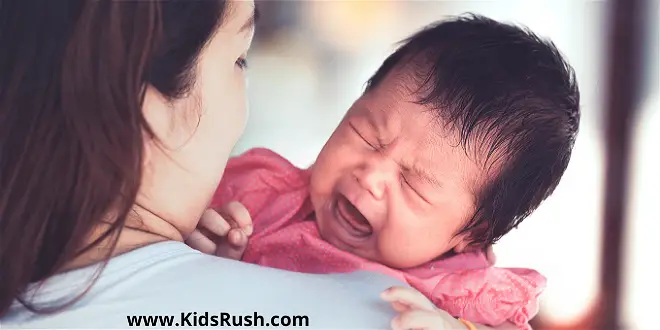Having a systematic approach to preventing crying spasms is the best way to keep children from displaying them.
Occasionally, a child may experience crying spells that scare his parents, but they are usually not common medical issues. These episodes usually occur and disappear without major consequences.
Children can lose consciousness while having crying spasms because they stop breathing and then suddenly start crying again. In some cases, they look like seizures, but they are not.
During crying spasms, the child’s emotions become volatile, resulting in spasms or fits of crying. This behavior usually occurs between six months and three years of age. For some children, crying fits happen only occasionally, while others display them all of the time.
Crying spasms and types of them

The child stops breathing when he begins a crying spell, which often leads to fainting. There are two types, and each has its own characteristics.
Cry spells can be broken into two types:
- Cyanotic crying spasms. Children suffer from these most commonly under the influence of anger or frustration. Their face fades gradually into a shade of blue and in extreme cases becomes purple. [1]
- Pale crying spasms. These manifestations occur when a child has a sudden start, intense fear, or has a painful experience. Unlike previous behaviors, paleness can be observed in these children. The heart rate low. [2]
Read Also: Salmonella In Kids: Signs, Symptoms, Diagnosis, and Treatment
Crying spasms are caused by what?
Although the science is not aware of the precise cause of crying spells, we know that it is likely caused by either an intense emotional state or sudden physical pain. We also know that breathing changes and heart rate decreases during crying spells.
The exact cause of this condition is not known; however, it has been established that in approximately one-third of children who exhibit these episodes, their parents also go through similar episodes. Likewise, iron deficiency anemia is shown to contribute to the occurrence of crying spells.
A child’s inability to breathe does not occur due to a chemical imbalance but is caused by causes other than genetics.
Discover: Vitamin D Deficiency In Children
Related symptoms
Crying spells manifest in a variety of ways, and they vary based on the description. Blue spasms, or cyanotic breath-holding, are mainly manifested by the following manifestations:
- Crying with or without screaming.
- This child exhales forcefully, and he then takes a deep breath but does not inhale.
- Lack of oxygen causes a blue hue around the mouth. Since the skin lacks oxygen, it takes on a blue hue.
- There may be fainting when the body becomes weak.
There are two symptoms in pale breathlessness or pale spasms:
- Although the child is trying to scream or cry, they cannot make sounds out of their mouths.
- It seems as though he is almost completely white after fainting and looking pale.
- It takes a few minutes for the arms and legs to become stiff.
- At times, they can lose control of their bladder or bowels.
Read Also: Why Is My Baby Vomiting When They Do not Have a Fever?
What is the best time to get medical attention?

Doctors suggest seeking medical attention from the very first episode of crying spells. They say it is best to consult a health professional and get an expert diagnosis so that you do not assume it is this problem.
A heart arrhythmia, iron deficiency anemia, or seizure disorders must be ruled out before these types of spasms are all the result of an intense emotional and physical response to unpleasant stimuli.
This is why seeing a doctor is extremely important:
- The episodes tend to be more frequent when the frequency is very high.
- Episodes lasting longer than two minutes.
- After the episode is over the child will still appear confused or sleepy.
- Typically, children with questionable health conditions should be seen by a physician.
Read Also: Baby Vomiting: Causes, Remedies and Treatment
Diagnosis and treatments of the crying spasms
Generally, crying spells do not respond to specific testing, but it is advisable for parents to document what happens during crying spells and to report them to a doctor. The most common diagnostic method consists of the combination of information and a clinical examination.
Doctors may refer a child to another doctor or suggest some clinical tests or clinics if they suspect another health problem is involved.
Although the episode may sometimes persist, most commonly this problem is cured by time. Occasionally anemia can be treated with iron supplements. Although this can be frustrating for parents, the best thing to do is to wait and see what goes away.
Discover: Hypotonia Or Floppy Infant Syndrome: Symptoms, Causes, And Treatment
Prevention and recommendations for crying spasms
The doctor, in principle, will help the parents identify the triggers of the episodes in the child. Crying spasms occur until the child finds better ways to deal with frustration or anger.
Then, the child can be disciplined without causing spasms through mechanisms and strategies. The parent will also be instructed to develop more coping skills that are needed to learn to set limits for the child and coexist with the child.
During difficult periods, parents must avoid giving in to them and allow them to begin being emotional. As a result, parents should remain calm. With younger children, a few blows on their faces often suffice.
- Check the child’s mouth for any foreign objects. Dispose of them.
- Make sure the child is on his side.
- Take care not to break or damage objects nearby. If you suddenly move or have a seizure, you could harm yourself.
- Then call or go to an emergency room if you cannot catch your breath after one minute.
Related: What Are the Risks and Benefits Of Giving An Infant Benadryl?
Crying spasms are usually not serious
The crying spells may cause a great deal of distress for parents. However, it should be noted that in many cases they do not pose any danger. If there is any difficulty in handling the situation, it is best to consult with your pediatrician for assistance.
A child needs to learn ways to handle his emotions particularly fear, anger, and frustration. He should be encouraged to speak his feelings out loud. He should be given a method of relaxing and resting appropriately.
You May Like Also: Probiotics for Children: Are They Healthy For Your Kids?
